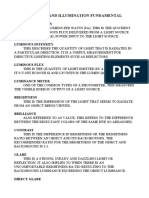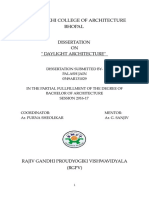Natural and Artificial Lighting
Natural and Artificial Lighting
Uploaded by
Rajat GandhiCopyright:
Available Formats
Natural and Artificial Lighting
Natural and Artificial Lighting
Uploaded by
Rajat GandhiOriginal Description:
Original Title
Copyright
Available Formats
Share this document
Did you find this document useful?
Is this content inappropriate?
Copyright:
Available Formats
Natural and Artificial Lighting
Natural and Artificial Lighting
Uploaded by
Rajat GandhiCopyright:
Available Formats
BUILDING SERVICES - IV
ASSIGNMENT I
SUBMITTED BY: Sumeet Dagar B.Arch Semester IV 11001006035
Lighting in architecture is both a science and an art. Lighting of structures must consider aesthetic elements as well as practical considerations of quantity of light required, occupants of the structure, energy efficiency and cost. And lighting in architecture can be executed by the means of natural lighting or artificial lighting which are explained as following:
1. Natural lighting:
Natural lighting entering a building all originates from solar radiation, but it may have arrived by a number of different routes, each of which will have modified it in various ways.
Solar radiation when it reaches the earths atmosphere covers a wide spectrum of wavelengths, including the range of visible light, ranging from red at the longest wavelengths of about 700 nm to violet at the shortest wavelengths of about 400 nm.
This is selectively filtered by the atmosphere, so that the radiation reaching the surface of the earth is less than that above the atmosphere.
The natural lighting entering a building may include direct sunlight when the window has a view of the sun, as well as diffuse sunlight that has been refracted by clouds, and reflected from various surfaces such as clouds, ground or other buildings.
Natural light can therefore vary greatly with weather conditions, ranging from total cloud cover to clear sky with direct sunlight.
Natural light has the potential to provide large amounts of effectively free energy, reducing the amount of electricity required to achieve a given level of lighting.
However natural lighting must be designed with care to ensure a high quality of light for the users.
The effectiveness of natural light as a light source is measured as the Daylight Factor. This is the average illuminance (lux) inside a room at a standard height above floor level compared to the illuminance outdoors on an overcast day. It is usually stated as a percentage. Typically the daylight factor should be between 2-5%. Less than 2% is experienced as a dim space, whereas over 5% results in unnecessary heat gain. The illuminance of the sky is typically in the range 20,000 to 100,000 in direct sun, and between 5,000 to 20,000 when the sky is overcast. Two potential problems associated with the use of natural lighting buildings are glare and heat.
Glare occurs when a bright light source such as the sun is in the field of view of users. It can also occur when reflections of the sun are in the field of view. The simplest way to control glare is to avoid large windows on the east and west elevations, and ensure that windows on the north elevation are shaded to control the low winter sun. The south elevation is very seldom exposed to direct sun, and even then it is at an oblique angle that is less of a problem.
For windows that are exposed to direct sun at certain times of day and year, this can be controlled by careful design of the geometry of windows and the use of shading devices such as blinds or shutters.
Generally daylight entering through windows provides far higher light levels than are actually required; resulting in significant associated heat
gains. Typically the heat input from direct solar radiation on a horizontal plane is about 900W/m2, whereas indirect radiation through a window is typically 350W/m2 at midday in summer.
2. Artificial lighting: Incandescent lamp: o Until recently the most common electric light source was the incandescent lamp. This is still widely used, although its relatively low energy efficiency is leading to its replacement by other more efficient lamps such as the CFL. The connection to a light fitting is either by screw thread or bayonet. o A large variety of shapes, sizes and power is available, as well as different colour ranges. Typical lamps for household use range from about 40 to 100 W, giving a light output of 420 to 1360lm at the typical lamp efficiency of about 12%.
Compact fluorescent lamp: o The compact fluorescent lamp (CFL) was designed as a more efficient replacement for incandescent lamp. It is supplied with the same fixing system (screw or bayonet), and can be used in many light fittings designed for incandescent lamps. o Power ratings of CFLs that can provide approximately the equivalent light output to incandescent lamps are shown in the table below, together with their efficacy ratings.
Fluorescent tube: o Fluorescent tubes are the main form of lighting for offices and commercial buildings. o They are a form of gas discharge lamp, and are formed in a long thin glass cylinder with contacts at either end that secure them to the fitting (or luminaire) and provide the electrical connection. o The tube contains mercury vapour at low pressure, and the inner wall of the glass is coated with a phosphor that reacts to ultra-violet radiation. When electricity is passed through the vapour it emits UV radiation that is converted by the phosphor to visible light. o The most efficient fluorescent tubes are the T5. With a smaller diameter (16mm) than earlier tubes, these can achieve a luminous efficacy of up to 104lm/W.
Discharge lamps: o Discharge lamps work by striking an electrical arc between two electrodes, causing a filler gas to give off light. o Different metals and filler gasses can be used to provide a range of colour and brightness. o Discharge lamps provide high luminous efficacy combined with long life, resulting in the most economical light source available.
Light Emitting Diode (LED): o LEDs use semi-conductors to convert electrical energy directly into light. They are only recently becoming available as a light source for lighting purposes, and are highly efficient and long lasting. o LED torches are becoming very popular, as they provide a far longer battery life than other types of light source.
Role of lighting around us: The perception of space is directly connected to the way light integrates with it. What we see, what we experience and how we interpret the elements is affected by how light interacts with us and with the environment. Regarding architecture, in whatever dimension it can be analysed, either as space, as material or as colour, it is essentially dependant on the lighting situation that involves both the object and the observer. The dynamic daylight and the controlled artificial lighting are able to affect not only distinct physical measurable conditions in a space, but also to instigate and provoke different visual experiences and moods. Due to the light, it is possible to perceive different atmospheres in the same physical environment. So it can be said that light is a fundamental element to architecture; it interacts with the space, affecting the way we perceive it. The way lighting acts can change the spatiality, the atmosphere and the visibility. The lit environment deals with brightness, shadows, lighting distribution, colour and many other aspects that influence our visual experience and plays with our mood.
You might also like
- Building Services-II Module - 2Document24 pagesBuilding Services-II Module - 2Neha AlbertNo ratings yet
- The Brain: Our Universe WithinDocument7 pagesThe Brain: Our Universe WithinSally Morem67% (3)
- Light and Architectural Lighting SystemsDocument2 pagesLight and Architectural Lighting SystemsRowswelle SungaNo ratings yet
- Lecture 3 - Natural and Artificial Lighting in Architecture - Ar Intrs 312Document110 pagesLecture 3 - Natural and Artificial Lighting in Architecture - Ar Intrs 312Kia changgiNo ratings yet
- Daylighting Guide For Buildings PDFDocument23 pagesDaylighting Guide For Buildings PDFShaaya ShanmugaNo ratings yet
- LightingDocument15 pagesLightingPogpog ReyesNo ratings yet
- Types of LightingDocument6 pagesTypes of Lightingluh gagiNo ratings yet
- ArchID - Light in Architecture and Psychology of Light PDFDocument21 pagesArchID - Light in Architecture and Psychology of Light PDFpopzifizzilefaerydaeNo ratings yet
- Module 2V - Light & Lighting FundamentalsDocument6 pagesModule 2V - Light & Lighting Fundamentalsraul_bsu100% (2)
- Project: Auditorium Aspect: Auditorium Lighting: IntrodutionDocument9 pagesProject: Auditorium Aspect: Auditorium Lighting: IntrodutionAizaz KhanNo ratings yet
- Lighting Concepts: ResidentialDocument13 pagesLighting Concepts: ResidentialVasilis KarageorgiouNo ratings yet
- Aar604 Lecture 3Document55 pagesAar604 Lecture 3Azizul100% (1)
- Erco Guide en PDFDocument436 pagesErco Guide en PDFroyvindasNo ratings yet
- Daylighting Design StrategiesDocument11 pagesDaylighting Design StrategiesdasaNo ratings yet
- Lighting DesignDocument52 pagesLighting DesignChyleYhvan PenalesNo ratings yet
- Illumination Basic and SchemeDocument33 pagesIllumination Basic and Schemegoitom01No ratings yet
- Illumination FullDocument44 pagesIllumination FullNaanaa PalaniNo ratings yet
- Daylight in ArchitectureDocument39 pagesDaylight in ArchitectureGopi KrishnaNo ratings yet
- Facade PresentationDocument67 pagesFacade PresentationEsraa KhairyNo ratings yet
- SS405 Office LightingDocument9 pagesSS405 Office LightingEnrique TorrezNo ratings yet
- Unit 3 LightingDocument37 pagesUnit 3 LightingarialoraineNo ratings yet
- DAYLIGHTINGDocument33 pagesDAYLIGHTINGAnurag Biswas50% (2)
- Lighting Design ConsiderationsDocument42 pagesLighting Design Considerationsshivam007No ratings yet
- Theory of Architecture: Architect and Urban PlannerDocument50 pagesTheory of Architecture: Architect and Urban PlannerRiz Ann PapaNo ratings yet
- Building ServicesDocument9 pagesBuilding ServicesPriya SinghalNo ratings yet
- Artificial LightingDocument37 pagesArtificial LightingArjay Garlan100% (1)
- 606 - Lec - 4 - Lighting & Illumination, Colour PDFDocument48 pages606 - Lec - 4 - Lighting & Illumination, Colour PDFsakshi shakya100% (1)
- Lighting 1Document11 pagesLighting 1Gabriel RoaNo ratings yet
- Tropical Design Theories Concepts and ST PDFDocument2 pagesTropical Design Theories Concepts and ST PDFAr CesNo ratings yet
- Services LIGHTINGDocument34 pagesServices LIGHTINGAmit Kumar YadavNo ratings yet
- Lighting Design - Whole Building Design GuideDocument4 pagesLighting Design - Whole Building Design Guideyarzar172040No ratings yet
- Project Management: Building EconomicsDocument2 pagesProject Management: Building Economicsa_j_sanyal259No ratings yet
- Chapter 2Document23 pagesChapter 2Melkamu BirlewNo ratings yet
- Illumination 2Document35 pagesIllumination 2John JNo ratings yet
- Daylighting For Indoor SpacesDocument37 pagesDaylighting For Indoor SpacesZahidNo ratings yet
- Lighting and Illumination FundamentalsDocument8 pagesLighting and Illumination FundamentalsOkay AkoNo ratings yet
- 3 YEAR BUILDING SERVICES-illumination PDFDocument44 pages3 YEAR BUILDING SERVICES-illumination PDFanurag gupta100% (2)
- Interior ErgonomicsDocument8 pagesInterior Ergonomicsv_anand78No ratings yet
- Architectural Design Student CenterDocument9 pagesArchitectural Design Student CenterLeen RimawiNo ratings yet
- Principles of IlluminationDocument15 pagesPrinciples of IlluminationEddieson Alorro100% (4)
- Lighting and Electrical FixturesDocument75 pagesLighting and Electrical Fixturesjhyl aquinoNo ratings yet
- Unit 2 IlluminationDocument56 pagesUnit 2 IlluminationsiddharthaNo ratings yet
- AI Theories and Principles of Architectural InteriorsDocument26 pagesAI Theories and Principles of Architectural InteriorsWINONA DASHA ESPIÑANo ratings yet
- Concept BoardDocument3 pagesConcept BoardMelissa Serrano100% (1)
- Lighting Unit 4Document119 pagesLighting Unit 4udhayakumar masilamaniNo ratings yet
- Toilet DetailDocument1 pageToilet DetailF. SarfaraziNo ratings yet
- DaylightDocument5 pagesDaylightSanjana SahajramaniNo ratings yet
- Shadow Angles and Shading DevicesDocument21 pagesShadow Angles and Shading DevicesmarchNo ratings yet
- Acc Building Utilities 4Document8 pagesAcc Building Utilities 4Zane BevsNo ratings yet
- Supermarket: New Era University College of Engineering and Architecture Bachelor of Science in ArchitectureDocument14 pagesSupermarket: New Era University College of Engineering and Architecture Bachelor of Science in ArchitectureLorraine Anne Rollo BagangNo ratings yet
- Acoustic and Lighting Analysis of Heriott Watt UniversityDocument63 pagesAcoustic and Lighting Analysis of Heriott Watt UniversitySyazleen SiesNo ratings yet
- Acoustical Defects in Enclosed SpaceDocument27 pagesAcoustical Defects in Enclosed SpacePrateekNo ratings yet
- Roof LightsDocument10 pagesRoof LightsTushar JainNo ratings yet
- Artificial LightDocument34 pagesArtificial LightJohn KaruwalNo ratings yet
- Daylight ArchitectureDocument26 pagesDaylight ArchitecturePalash Jain50% (2)
- Room Acoustic Lecture 2 PDFDocument68 pagesRoom Acoustic Lecture 2 PDFSeid AbdulefetahNo ratings yet
- Illumination Technology - Module-1 - For Students (Edited)Document72 pagesIllumination Technology - Module-1 - For Students (Edited)rakzzzachuzzzNo ratings yet
- AR 8522 - unit 2Document90 pagesAR 8522 - unit 2Venkateshwaran AthankarayanNo ratings yet
- EET463 M1 Ktunotes - inDocument60 pagesEET463 M1 Ktunotes - inAlwin Jose AdamNo ratings yet
- Illumination AssignmentDocument15 pagesIllumination AssignmentShadowdare VirkNo ratings yet
- Preface: SevenDocument60 pagesPreface: Seven24.Mr.Theutthavy Pms 7/6No ratings yet
- CE132P - Theory of Structures 2: Engr. Keith Anshilo DiazDocument3 pagesCE132P - Theory of Structures 2: Engr. Keith Anshilo DiazKeith Anshilo DiazNo ratings yet
- Example of A Quantitative Research PaperDocument11 pagesExample of A Quantitative Research PaperZ FuuNo ratings yet
- 1 s2.0 S0167732224001119 MainDocument19 pages1 s2.0 S0167732224001119 Mainmanda azkiNo ratings yet
- Cambridge International General Certificate of Secondary EducationDocument28 pagesCambridge International General Certificate of Secondary EducationJahangir KhanNo ratings yet
- Join Telegram: Garimagoel007 - g2: Hand Written Short Notes Digestion and AbsoptionDocument18 pagesJoin Telegram: Garimagoel007 - g2: Hand Written Short Notes Digestion and AbsoptionChirag RajpalNo ratings yet
- Tyco Next Generation BFV 300 Butterfly Valve 0116Document4 pagesTyco Next Generation BFV 300 Butterfly Valve 0116Benson MwineyaNo ratings yet
- Web Based Result Publication System For Education BoardsDocument2 pagesWeb Based Result Publication System For Education BoardsMELISSA RIOSNo ratings yet
- Merck Price List 2013-14Document372 pagesMerck Price List 2013-14drrcc0761100% (1)
- TLauncher Setup LogDocument5 pagesTLauncher Setup Logmelissa teresa bautista uwuNo ratings yet
- Bat Bot (B2) A Flying Inspired Machine Robot PDFDocument35 pagesBat Bot (B2) A Flying Inspired Machine Robot PDFBilal BilalNo ratings yet
- Trigona BeeDocument2 pagesTrigona Bee14I Nyoman Wijaya KusumaNo ratings yet
- Introduction To Programming: Pass Task 2.3: Hospital ChargesDocument3 pagesIntroduction To Programming: Pass Task 2.3: Hospital ChargesSyed MohiuddinNo ratings yet
- TH Wealth BlueprintDocument108 pagesTH Wealth BlueprintabimbolamorganNo ratings yet
- Hematology Topics Objectives References: Our Lady of Fatima University Department of Internal MedicineDocument7 pagesHematology Topics Objectives References: Our Lady of Fatima University Department of Internal MedicineAlmar NuñezNo ratings yet
- Research Problem, Conceptual and Theoretical FrameworkDocument22 pagesResearch Problem, Conceptual and Theoretical FrameworkAbdishakur Dahir MuseNo ratings yet
- Manual RIDO - 2Document25 pagesManual RIDO - 2messiahsNo ratings yet
- Maneco Midterm TPDocument2 pagesManeco Midterm TPAgapito Jr LamelaNo ratings yet
- PPG - Module 2 - 2ND Sem - 2ND Quarter - Grade 11 - Humss Bonifacio-Agoncillo - MR - Paombong - MRS CuencaDocument12 pagesPPG - Module 2 - 2ND Sem - 2ND Quarter - Grade 11 - Humss Bonifacio-Agoncillo - MR - Paombong - MRS CuencaArnold Paombong100% (1)
- 04 - Sanjana Bhandiwad - Assignment 2 - Basement ExcavationDocument27 pages04 - Sanjana Bhandiwad - Assignment 2 - Basement Excavation04BHANDIWAD SANJANA100% (1)
- Guia TeraSpanDocument73 pagesGuia TeraSpanTim Robles MartínezNo ratings yet
- Addition and DeletionDocument10 pagesAddition and DeletionNikkaMontilNo ratings yet
- Test Document: Date Tester Test Notes ResultsDocument8 pagesTest Document: Date Tester Test Notes Resultsaruna777No ratings yet
- Kindun - The Desert KingdomDocument38 pagesKindun - The Desert Kingdomdizman021No ratings yet
- RS Handbook Fall Final 2022upDocument27 pagesRS Handbook Fall Final 2022upIbrahim AlifNo ratings yet
- FRANC3D V7 Training - Part 9 - Session LogDocument3 pagesFRANC3D V7 Training - Part 9 - Session LogsanthoshnlNo ratings yet
- P2201 Operating Instruction Manual: Low Velocity Powder Actuated Fastening ToolDocument32 pagesP2201 Operating Instruction Manual: Low Velocity Powder Actuated Fastening TooleguillenNo ratings yet
- Link Belt X4 Long Front FamilyDocument12 pagesLink Belt X4 Long Front FamilyYew LimNo ratings yet
- Thesis Activity UpdatedDocument1 pageThesis Activity UpdatedDainty Loren BarramedaNo ratings yet

























































































